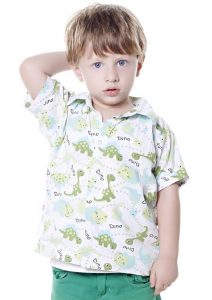I heard Marianne talk about her research into textual and visual messages on girls’ and boys’ t-shirts at the PALA 2018 conference. I was fascinated. Of course, we all know about the pink vs blue war in children’s retail but for some time now I have been under the impression that things might slowly be changing – especially with movements like ‘Let toys be toys’ and ‘Let clothes be clothes’. But as Marianne shows in her research, this seems not to be the case so much. Marianne has collected an extensive corpus of textual messages from children’s t-shirts sold by some of the major retailers and it is far from only about colours… So before you set off for your Christmas shopping, do read on.
Marianne Cronin recently completed her PhD in Applied Linguistics at the University of Birmingham. In 2017, she started the ‘Gender and Children’s Clothing Project’ (which she has snappily titled the ‘GCCP’) after noticing the outdated conceptualisations of gender that are printed on children’s clothes in the UK. She presented this research at the 2018 PALA conference in Birmingham and is now working on a journal article based on this research. She hopes to continue this project to its next phase using empirical research with children and parents/caregivers. Marianne currently splits her time between Birmingham, Loughborough and Coventry where she lectures on a variety of undergraduate language modules.
***
It’s a crowded Saturday afternoon at Birmingham New Street Station. Shoppers with carrier bags are buzzing around, heading for the various platforms. I spot a girl among the hive of people, she’s about six years old and is holding her mother’s hand as they make their way to the ticket barriers. She’s wearing a pink t-shirt that says ‘LOVE’ and it’s covered in sequin hearts. Before I’ve left the station, I pass a boy with his parents and several older brothers. His jumper reads ‘Little Monster’ and is accompanied by a brightly coloured cartoon monster with pointed teeth.
It’s not that I’m personally fascinated with the sartorial choices of children, but since I started the Gender and Children’s Clothing Project, I can’t help but notice the writing on children’s clothing around me. I began work on the project in 2017 when, having scoured the internet for a gift for a friend’s new baby, I discovered that the text printed on clothing for children contained highly gendered language with implications of conceptualisations of gender that I thought were no longer considered viable in society. The more I explored, the more I found that while girls’ clothing of all ages was adorned with sparkles, glitter and love, boys’ clothing was awash with dinosaurs, dudes, and monsters. When I couldn’t find any linguistic research on the text printed on children’s clothing, I was inspired to start my own.
The Gender and Children’s Clothing Project explores the language printed on children’s t-shirts with a particular emphasis on how gendered identities are constructed. My corpus of children’s clothing consists of 500 t-shirts from 13 UK retailers. 250 of the t-shirts were classified by the retailers as being for ‘girls’ and 250 t-shirts for ‘boys’. They come from a range of retailers including supermarkets, fashion chains and department stores. To enable a fair comparison of target audience, items were only included if they were available for a child of 5 years old. I conducted a corpus analysis of my data using AntConc and a thematic content analysis using NVivo.

One of the key points of difference that emerged from the data was education. Palaeontology was a prominent subject in the boys’ clothing. 11% of the boys’ tops referenced dinosaurs through text and/or imaging. This finding is reflected in the keyword analysis, where dino, rex, tyrannosaurus, and stegosaurus appeared in the top 15 keywords when my boys’ clothing corpus was compared with the BNC Written corpus.
Some of the boys’ palaeontological items featured anthropomorphised dinosaurs, for example one t-shirt from department store Next depicts a t-rex wearing pink headphones with the caption ‘DJ Rex, drop the beat’. Most, however, featured not only detailed graphic representations of dinosaurs that are in line with scientific images of the creatures, but also detailed educational information about dinosaurs:
| Retailer | Age Range of Product | Gender category provided by retailer | Text on T-shirt |
| Debenhams | 12 months – 6 years | Boys | There were over 700 different species of dinosaurs
The tallest dino could grow to be 18.5 metres in height Pterodactyls had a 3.5ft wingspan Dinosaurs walked the earth over 65 million years ago |
| H&M | 1.5 – 10 years | Boys | Tyrannosaurus Rex Dino Stats:
coelurosaurs theropod dinosaur |
The t-shirts above provide learning opportunities about dinosaurs, including their size, weight, Latinate name, species variation, habitat and the time they are estimated to have existed. Alongside this, the presence of low-frequency polysyllabic words such as ‘tyrannosaur’ and ‘pterodactyl’ introduce the child wearer of this t-shirt to a complex and specialised vocabulary.
Turning now to the girls’ data set, only 2% of the girls’ items referenced dinosaurs and they were depicted through imaging only. Furthermore, when dinosaurs did appear in girls’ clothing, they were depicted in highly feminised ways. One t-shirt from department store Debenhams depicts a pink dinosaur with sequin spots who is wearing a pink neck tie. Another from fashion retailer Zara depicts a bright pink dinosaur whose eyelashes are exaggerated giving the effect that the dinosaur is wearing mascara. In the case of palaeontology, girls are significantly disadvantaged by an absence of the learning opportunities provided in the boys’ clothing.
There was also some evidence of a rejection of school (and by implication education) in the girls’ data:
| Retailer | Age Range of Product | Gender category provided by retailer | Text on T-shirt |
| Mango | 4 – 14 years | Girls | Do I have to go back to school? |
| River Island | 5 – 12 years | Girls | Less Mondays
More Fridays |

In addition to the items above from Mango and River Island that explicitly and implicitly reject the school week (respectively), the girls’ top 15 keywords against the BNC showed no indication of educational content, with photic words sparkle, shine and glitter all featuring in the top keywords. Love was also a strongly key word and was accompanied by other positive words such as happy and yay. The strongest keyword in the girls’ clothing corpus was unicorn, with 13 tokens in the data set.
| Retailer | Age Range of Product | Gender category provided by retailer | Text on T-shirt |
| Sainsbury’s TU | 9 months – 6 years | Girls | Always be a unicorn |
| Debenhams | 4 years – 14 years | Girls | I wish I was a unicorn |
The popularity of unicorns in my girls’ data set reflects the current trend for the mythical beasts (Fisher 2017). As Professor Susan Hunston recently wrote in an article for the Glare project, unicorn has shown a marked increase in frequency of use by children since 2017. The emphasis in girls’ clothing, then, appears to be on fantasy, positive pro-social behaviours and somewhat meaningless photic terms.
Indeed, dinosaur never appears in the girls’ data set, and unicorn never appears in the boys’. In other words, dinosaurs and unicorns are segregated with the implication that dinosaurs are for boys and unicorns are for girls. It is possible that such early priming of palaeontology as a male space may be one of the factors leading to the significant gender imbalance in the field (Switek 2018).
And this is only one aspect of the data set. My findings also show that genius occurs numerous times in the boys’ data but only occurs in the girls’ data when premodified with girl, i.e. girl genius. Likewise, dance and dancing are words that only occur in the girls’ clothing.
But why does this matter? Research by Adam and Galinsky (2012) suggests that the clothing we wear can affect the way we behave. They propose the term ‘enclothed cognition’ to explain that “when a piece of clothing is worn, it exerts an influence on the wearer’s psychological processes” (2012:919). They found that participants paid more attention to a task when they were asked to wear a coat described as a doctor’s coat than when that same coat was described as a painter’s coat. They state that enclothed cognition takes place when someone wears a piece of clothing whilst at the same time understanding its symbolic meaning. It is possible, then, that if a child is given a t-shirt that reads genius, and they understand the meaning of that word, they may behave in a way that they believe to be congruent with a genius – working for educational attainment, paying attention, etc. Likewise, a child wearing a t-shirt reading dancer might act in a way congruent with their understanding of a dancer. This is a hypothesis I hope to test in the future.
Furthermore, the presence of educational content in boys’ clothing and absence in the girls’ clothing may reflect the males = brilliance stereotype. Research by Bian, Leslie and Cimpian (2017) has shown that by the time they are six years old, girls are “less likely than boys to believe that members of their gender are ‘really, really smart’” (2017:391) even when the girls’ performance in school exceeds that of the boys (2017:390). They also found that girls were less likely than boys to attempt tasks described as suitable for smart children (2017:390). Crucially, their study indicates that between the ages of 5 and 7 children’s beliefs about their gender’s abilities go through a period of change. Clothing may be one of the sources of skewed gender perceptions that are impacting children at this crucial time.
A piece of advice often given to parents/carers and discussed by the BBC is that when shopping for children at Christmas they should give the child something to wear, something to read, something they want and something they need. With the festive season coming up, I would encourage the gender-conscious parent/carer to pay attention to the construction of gender in the clothing being sold to them and their children. Future generations will thank us for working to disentangle science and fantasy from outdated notions of gender. Free the unicorns and dinosaurs!
References:
Adam, H. & Galinsky, A. D. (2012). Enclothed Cognition. Journal of Experimental Social Psychology 48, 918-925.
Bian, L., Leslie, S.-J. & Cimpian, A. (2017). Gender Stereotypes about intellectual ability emerge early and influence children’s interests. Science 355, 389-391.
Lopez-Perez, B., Ambrona, T., Wilson, E. L. & Khalil, M. (2016). The effect of enclothed cognition on empathic responses and helping behaviour. Social Psychology 47 (4), 223-231.
Please cite this blog post as follows: Cronin, M. (2018, 3 December). Dinosaurs vs. Unicorns [Blog post]. Retrieved from: https://blog.bham.ac.uk/glareproject/2018/12/03/dinosaurs-vs-unicorns/

Join the discussion
0 people are already talking about this, why not let us know what you think?